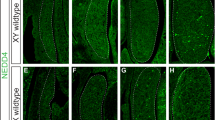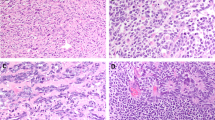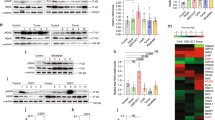Abstract
Patients with disorders of sex development (DSD), especially those with gonadal dysgenesis and hypovirilization, are at risk of developing the so-called type II germ cell tumors (GCTs). Both carcinoma in situ and gonadoblastoma (GB) can be the precursor lesion, resulting in a seminomatous or non-seminomatous invasive cancer. SRY mutations residing in the HMG domain are found in 10–15% of 46,XY gonadal dysgenesis cases. This domain contains two nuclear localization signals (NLSs). In this study, we report a unique case of a phenotypical normal woman, diagnosed as a patient with 46,XY gonadal dysgenesis, with an NLS missense mutation, on the basis of the histological diagnosis of a unilateral GB. The normal role of SRY in gonadal development is the upregulation of SOX9 expression. The premalignant lesion of the initially removed gonad was positive for OCT3/4, TSPY and stem cell factor in germ cells, and for FOXL2 in the stromal component (ie, granulosa cells), but not for SOX9. On the basis of these findings, prophylactical gonadectomy of the other gonad was performed, also showing a GB lesion positive for both FOXL2 (ovary) and SOX9 (testis). The identified W70L mutation in the SRY gene resulted in a 50% reduction in the nuclear accumulation of the mutant protein compared with wild type. This likely explains the diminished SOX9 expression, and therefore the lack of proper Sertoli cell differentiation during development. This case shows the value of the proper diagnosis of human GCTs in identification of patients with DSD, which allows subsequent early diagnosis and prevention of the development of an invasive cancer, likely to be treated by chemotherapy at young age.
Similar content being viewed by others
Log in or create a free account to read this content
Gain free access to this article, as well as selected content from this journal and more on nature.com
or
References
Hughes IA, Houk C, Ahmed SF, Lee PA, Group LC, Group EC : Consensus statement on management of intersex disorders. Arch Dis Child 2006; 91: 554–563.
Cools M, Drop SL, Wolffenbuttel KP, Oosterhuis JW, Looijenga LH : Germ cell tumors in the intersex gonad: old paths, new directions, moving frontiers. Endocr Rev 2006; 27: 468–484.
Sekido R, Bar I, Narvaez V, Penny G, Lovell-Badge R : SOX9 is up-regulated by the transient expression of SRY specifically in Sertoli cell precursors. Dev Biol 2004; 274: 271–279.
Wilhelm D, Martinson F, Bradford S et al: Sertoli cell differentiation is induced both cell-autonomously and through prostaglandin signaling during mammalian sex determination. Dev Biol 2005; 287: 111–124.
Sekido R, Lovell-Badge R : Sex determination involves synergistic action of SRY and SF1 on a specific Sox9 enhancer. Nature 2008; 453: 930–934.
Wilhelm D, Koopman P : The makings of maleness: towards an integrated view of male sexual development. Nat Rev Genet 2006; 7: 620–631.
Harley VR, Lovell-Badge R, Goodfellow PN : Definition of a consensus DNA binding site for SRY. Nucleic Acids Res 1994; 22: 1500–1501.
Giese K, Pagel J, Grosschedl R : Distinct DNA-binding properties of the high mobility group domain of murine and human SRY sex-determining factors. Proc Natl Acad Sci USA 1994; 91: 3368–3372.
Scully RE : Gonadoblastoma/ a review of 74 cases. Cancer 1970; 25: 1340–1356.
Oosterhuis JW, Looijenga LH : Testicular germ-cell tumours in a broader perspective. Nat Rev Cancer 2005; 5: 210–222.
Hersmus R, Kalfa N, de Leeuw B et al: FOXL2 and SOX9 as parameters of female and male gonadal differentiation in patients with various forms of disorders of sex development (DSD). J Pathol 2008; 215: 31–38.
Almstrup K, Ottesen AM, Sonne SB et al: Genomic and gene expression signature of the pre-invasive testicular carcinoma in situ. Cell Tissue Res 2005.
Honecker F, Stoop H, de Krijger RR, Chris Lau YF, Bokemeyer C, Looijenga LH : Pathobiological implications of the expression of markers of testicular carcinoma in situ by fetal germ cells. J Pathol 2004; 203: 849–857.
Looijenga LH, Stoop H, de Leeuw HP et al: POU5F1 (OCT3/4) identifies cells with pluripotent potential in human germ cell tumors. Cancer Res 2003; 63: 2244–2250.
de Jong J, Stoop H, Dohle GR et al: Diagnostic value of OCT3/4 for pre-invasive and invasive testicular germ cell tumours. J Pathol 2005; 206: 242–249.
Cheng L, Sung MT, Cossu-Rocca P et al: OCT4: biological functions and clinical applications as a marker of germ cell neoplasia. J Pathol 2007; 211: 1–9.
Cools M, van Aerde K, Kersemaekers AM et al: Morphological and immunohistochemical differences between gonadal maturation delay and early germ cell neoplasia in patients with undervirilization syndromes. J Clin Endocrinol Metab 2005; 90: 5295–5303.
Stoop H, Honecker F, van de Geijn GJ et al: Stem cell factor as a novel diagnostic marker for early malignant germ cells. J Pathol 2008; 216: 43–54.
Page DC : Hypothesis: a Y-chromosomal gene causes gonadoblastoma in dysgenetic gonads. Development 1987; 101: 151–155.
Schnieders F, Dork T, Arnemann J, Vogel T, Werner M, Schmidtke J : Testis-specific protein, Y-encoded (TSPY) expression in testicular tissues. Hum Mol Genet 1996; 5: 1801–1807.
Lau Y, Chou P, Iezzoni J, Alonzo J, Komuves L : Expression of a candidate gene for the gonadoblastoma locus in gonadoblastoma and testicular seminoma. Cytogenet Cell Genet 2000; 91: 160–164.
Stoop H, Honecker F, Cools M, de Krijger R, Bokemeyer C, Looijenga LH : Differentiation and development of human female germ cells during prenatal gonadogenesis: an immunohistochemical study. Hum Reprod 2005; 20: 1466–1476.
Kido T, Lau YF : A Cre gene directed by a human TSPY promoter is specific for germ cells and neurons. Genesis 2005; 42: 263–275.
Harley VR, Layfield S, Mitchell CL et al: Defective importin beta recognition and nuclear import of the sex-determining factor SRY are associated with XY sex-reversing mutations. Proc Natl Acad Sci USA 2003; 100: 7045–7050.
Argentaro A, Sim H, Kelly S et al: A SOX9 defect of calmodulin-dependent nuclear import in campomelic dysplasia/autosomal sex reversal. J Biol Chem 2003; 278: 33839–33847.
De Jong J, Stoop J, Dohle GR et al: Diagnostic value of OCT3/4 for pre-invasive and invasive testicular germ cell tumors. J Pathol 2005; 206: 242–249.
Kehler J, Tolkunova E, Koschorz B et al: Oct4 is required for primordial germ cell survival. EMBO Rep 2004; 5: 1078–1083.
Kersemaekers AM, Honecker F, Stoop H et al: Identification of germ cells at risk for neoplastic transformation in gonadoblastoma: an immunohistochemical study for OCT3/4 and TSPY. Hum Pathol 2005; 36: 512–521.
Lau YF : Gonadoblastoma, testicular and prostate cancers, and the TSPY gene. Am J Hum Genet 1999; 64: 921–927.
Oram SW, Liu XX, Lee TL, Chan WY, Lau YF : TSPY potentiates cell proliferation and tumorigenesis by promoting cell cycle progression in HeLa and NIH3T3 cells. BMC Cancer 2006; 6: 154.
Li Y, Tabatabai ZL, Lee TL et al: The Y-encoded TSPY protein: a significant marker potentially plays a role in the pathogenesis of testicular germ cell tumors. Hum Pathol 2007; 38: 1470–1481.
Rosenberg C, Van Gurp RJ, Geelen E, Oosterhuis JW, Looijenga LH : Overrepresentation of the short arm of chromosome 12 is related to invasive growth of human testicular seminomas and nonseminomas. Oncogene 2000; 19: 5858–5862.
Summersgill B, Osin P, Lu YJ, Huddart R, Shipley J : Chromosomal imbalances associated with carcinoma in situ and associated testicular germ cell tumours of adolescents and adults. Br J Cancer 2001; 85: 213–220.
Foster JW, Dominguez-Steglich MA, Guioli S et al: Campomelic dysplasia and autosomal sex reversal caused by mutations in an SRY-related gene. Nature 1994; 372: 525–530.
Morais da Silva S, Hacker A, Harley V, Goodfellow P, Swain A, Lovell-Badge R : Sox9 expression during gonadal development implies a conserved role for the gene in testis differentiation in mammals and birds. Nat Genet 1996; 14: 62–68.
Schmidt D, Ovitt CE, Anlag K et al: The murine winged-helix transcription factor Foxl2 is required for granulosa cell differentiation and ovary maintenance. Development 2004; 131: 933–942.
Uda M, Ottolenghi C, Crisponi L et al: Foxl2 disruption causes mouse ovarian failure by pervasive blockage of follicle development. Hum Mol Genet 2004; 13: 1171–1181.
Barrionuevo F, Bagheri-Fam S, Klattig J et al: Homozygous inactivation of Sox9 causes complete XY sex reversal in mice. Biol Reprod 2006; 74: 195–201.
Albrecht KH, Eicher EM : Evidence that Sry is expressed in pre-Sertoli cells and Sertoli and granulosa cells have a common precursor. Dev Biol 2001; 240: 92–107.
Albrecht KH, Young M, Washburn LL, Eicher EM : Sry expression level and protein isoform differences play a role in abnormal testis development in C57BL/6J mice carrying certain Sry alleles. Genetics 2003; 164: 277–288.
Dewing P, Shi T, Horvath S, Vilain E : Sexually dimorphic gene expression in mouse brain precedes gonadal differentiation. Brain Res Mol Brain Res 2003; 118: 82–90.
De Vries GJ, Rissman EF, Simerly RB et al: A model system for study of sex chromosome effects on sexually dimorphic neural and behavioral traits. J Neurosci 2002; 22: 9005–9014.
Dewing P, Chiang CW, Sinchak K et al: Direct regulation of adult brain function by the male-specific factor SRY. Curr Biol 2006; 16: 415–420.
Acknowledgements
This work was financially supported by Translational Research Grant Erasmus MC 2006 (RH), Dutch Cancer Society Grant 2006-3607 (BdL) and the National Health and Medical Research Council Australia (VRH).
Author information
Authors and Affiliations
Corresponding author
Additional information
Conflict of interest
The authors declare no conflict of interest.
Rights and permissions
About this article
Cite this article
Hersmus, R., de Leeuw, B., Stoop, H. et al. A novel SRY missense mutation affecting nuclear import in a 46,XY female patient with bilateral gonadoblastoma. Eur J Hum Genet 17, 1642–1649 (2009). https://doi.org/10.1038/ejhg.2009.96
Received:
Revised:
Accepted:
Published:
Issue date:
DOI: https://doi.org/10.1038/ejhg.2009.96



